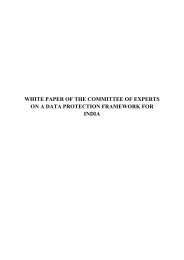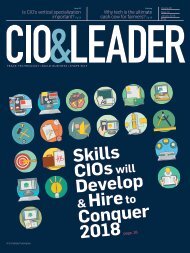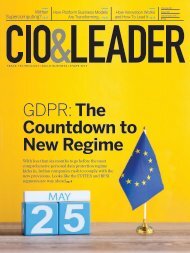CIO & LEADER-Issue-01-April 2018 (1)
You also want an ePaper? Increase the reach of your titles
YUMPU automatically turns print PDFs into web optimized ePapers that Google loves.
Column<br />
a result of the poor and unchanging<br />
condition of the state after 15 years<br />
of incumbent rule. In addition to the<br />
research phase, CA were tasked to<br />
organise the party base at the village<br />
level by creating a communication<br />
hierarchy to increase supporter<br />
motivation. Our client achieved a<br />
landslide victory, with over 90% of<br />
total seats targeted by CA being won,”<br />
the company’s website says.<br />
The 2<strong>01</strong>0 elections in Bihar was won<br />
by Nitish Kumar’s Janata Dal (United)<br />
against Lalu Prasad Yadav’s RJD, bettering<br />
their tally in the previous elections.<br />
Interestingly, CA was established<br />
by its parent company, Strategic<br />
Communications Lab (SCL) in 2<strong>01</strong>3.<br />
However, according to a report by the<br />
website thewire.in, SCL worked with<br />
a Ghaziabad-based company, Ovelene<br />
Business Intelligence (OBI), run by<br />
Amrish Tyagi, the son of senior JD(U)<br />
leader KC Tyagi.<br />
“OBI is Cambridge Analytica’s go-to<br />
company on the ground in the Indian<br />
subcontinent,” says thewire.in report. It<br />
quotes Tyagi junior who explains that<br />
being partners, they can use each other’s<br />
experience while making a pitch.<br />
This suggests that the work in 2<strong>01</strong>0<br />
Bihar elections was carried out by OBI.<br />
What it means is that full five years<br />
before Prashant Kishor’s ‘famed’<br />
election strategy and execution for<br />
JD(U)-RJD’s landslide in 2<strong>01</strong>5 Bihar<br />
assembly elections, the Big Data game<br />
was very much there in India.<br />
With India’s—and specifically<br />
Bihar’s—demographic reality,<br />
Facebook could have helped a little.<br />
So, it is primarily data analytics that<br />
can be credited for this successful show.<br />
I think that is something that is a<br />
takeaway from the entire episode. That<br />
Indian political parties were already<br />
doing this by 2<strong>01</strong>0, full six years<br />
before Trump won using ‘Big Data’<br />
in the US.<br />
It is now well-known that prime<br />
minister Modi too relied on data<br />
analytics (interestingly, same<br />
Prashant Kishor) in his 2<strong>01</strong>4 Lok<br />
Sabha elections. Maybe, he did that<br />
earlier in Gujarat elections too.<br />
In 2009, a strongman in a regional<br />
political party in Eastern India<br />
(who later fell out with his leader)<br />
used scientific data collection and<br />
juxtaposing that, with publicly<br />
available data, such as Census data<br />
and data from National S<strong>amp</strong>le<br />
Survey Organization, to create<br />
successful election strategies for his<br />
party. The party severed its ties with<br />
one of the national parties and came to<br />
power on its own in the elections.<br />
So, even in the muddy, free-for-all<br />
politics in India, political parties have<br />
started relying on data analytics,<br />
using both scientific data collection as<br />
well as making good use of publicly<br />
available data.<br />
According to report by<br />
Moneycontrol.com, Cambridge<br />
Analytica itself had started focusing<br />
on the 2<strong>01</strong>9 General Elections by<br />
being “in talks with a large opposition<br />
party in India” and had even made a<br />
presentation to the party in August.<br />
The report says it had “etched a datadriven<br />
strategy to target voters on<br />
social media, analyzing online user<br />
behaviour and connecting the dots<br />
across different citizen databases.”<br />
Where businesses lag<br />
All this raises an obvious question.<br />
Does this mean political parties are<br />
ahead in the Big Data game?<br />
In terms of usage of analytics tools,<br />
probably not. But one of the areas<br />
where political parties seem to have a<br />
clear lead is in using open data—or any<br />
publicly available data, for that matter.<br />
There could be four major sources of<br />
data for a business:<br />
1. Internally available data<br />
2. New data collected through custom<br />
research<br />
3. External data available publicly free<br />
or for a price and now<br />
4. Social media data, which is updated<br />
in real time.<br />
Out of the four, businesses have been<br />
focused mostly on the first two while<br />
Many<br />
businesses<br />
think unless<br />
they throw some<br />
big money and<br />
hire a big name<br />
to spend some<br />
time with, they<br />
cannot get any<br />
value out of<br />
their data<br />
the fourth has been the Holy Grail. But<br />
most of them have ignored the third<br />
one—publicly available data, that can<br />
add immense value to the businesses<br />
if analyzed in conjunction with their<br />
internal or research data.<br />
The social sector has been doing a lot<br />
of work using that data.<br />
“Many businesses think unless they<br />
throw some big money and hire a big<br />
name to spend some time with, they<br />
cannot get any value,” says a digital<br />
marketing executive and an open data<br />
enthusiast, rather bitterly.<br />
The whole thing provides the<br />
businesses with an opportunity to open<br />
their eyes to the possibilities that the<br />
political parties have already sensed.<br />
You do not have to steal data for<br />
that. You just have to think outsidein.<br />
Interestingly, the ability to do that<br />
has come as a strong pre-requisite<br />
for the digital leaders, in a research<br />
we have just completed on digital<br />
transformation in Indian companies.<br />
You may make or get amused by<br />
a smart, sarcasm-laden Twitter<br />
comment and move ahead, but it is<br />
also not such a bad idea to pause a bit<br />
and focus on the possibilities<br />
<strong>April</strong> 2<strong>01</strong>8 | <strong>CIO</strong>&<strong>LEADER</strong><br />
11














